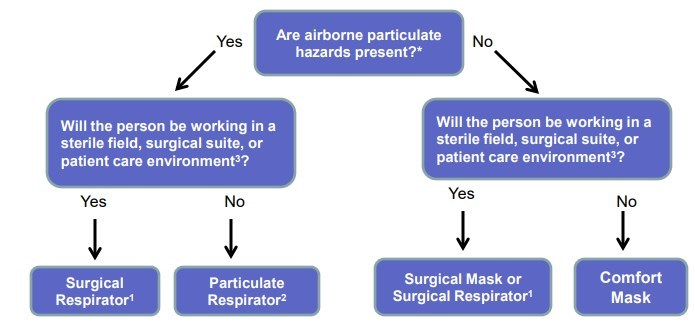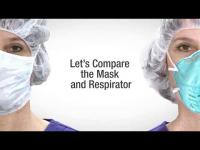Video
Video
Comfort Masks:
- Are not designed to protect your lungs from airborne hazards.
- Do not have the word NIOSH and the approval type (i.e. N95/P2) printed on the product.
- Are not cleared by the FDA for use as a surgical mask.
- Have not been tested to any government performance standards for filtration.
- Usually have only 1 head strap.
- Do not fit tightly to the face - there might be gaps around the edges.
Key Differences Between Respirators and Masks
Surgical Masks:
- Are cleared by the FDA for use as a surgical mask.
- Do not have the word NIOSH and the approval type (i.e. N95/P2) printed on the product.
- Are not designed to protect your lungs from airborne hazards.
- Are typically donned for a specific procedure and disposed of afterward.
- Help prevent large particles expelled by the wearer, such as spit or mucous, from entering the environment. If the wearer coughs or sneezes, the surgical mask will help collect the larger particles expeled.
- Usually do not fit tightly to the face—there might be gaps around the edges.
- Help reduce the spit and mucous the wearer expels out into the work area.
Surgical Respirators:
- Filter particles from the air when properly fitted, helping reduce the number of particles or germs the wearer breathes in .
- Are cleared by the FDA for use as a surgical respirator.
- Have the word NIOSH and the approval type (i.e. N95) printed on the product, when used in the US. P2 in Australia and Europe.
- Have packaging that typically refers to workplace hazards and OSHA compliance requirements.
- Are secured tightly to the face, usually with 2 head straps and an adjustable clip over the nose to allow for a more custom fit.
Potential Considerations for Selection of Respirators versus Surgical Masks
Employers may find the flow chart below helpful in their assessment of the type of disposable respirator or surgical mask that may be appropriate for a particular task.

- Selection of respiratory protection for occupational hazards is typically based upon the airborne concentration of the substance that the wearer is exposed to, and the occupational exposure limit (OEL) of that substance.
- Biological agents, such viruses and bacteria, do not have OELs; therefore employers should consider available guidance when selecting respirators. The US Centers for Disease Control and Prevention (CDC) has recommended that respirators offering more protection, such as powered air purifying respirators (PAPRs) may be considered in situations when high exposures to bacteria and viruses are possible.
- The occupational use of respirators in the US is regulated by the Occupational Safety and Health Administration (OSHA) and, in the US, the use of respirators in all workplaces must be per OSHA standard 29 CFR 1910.134.
- Tight fitting respirators such as the particulate respirators shown cannot be worn with facial hair or anything else that may interfere with the seal.
- For additional information see 3M Personal Safety Division Technical Data Bulletin 231.




